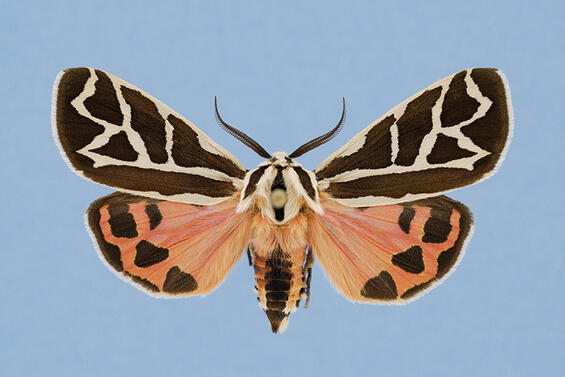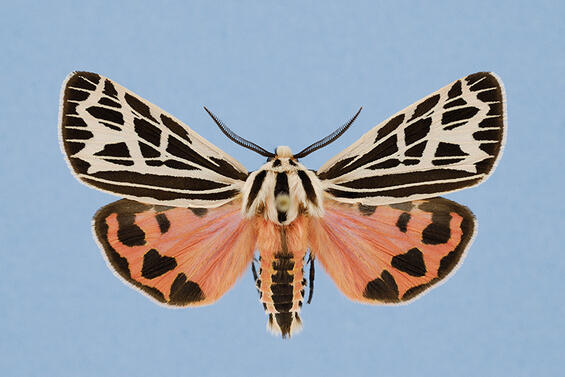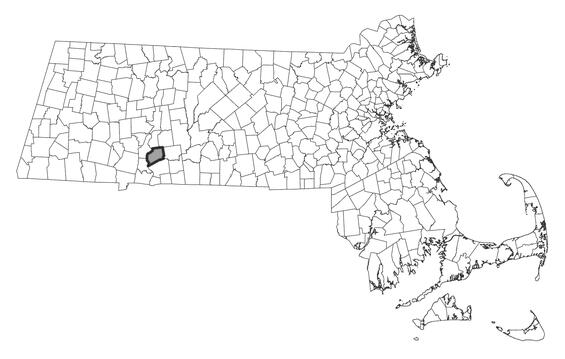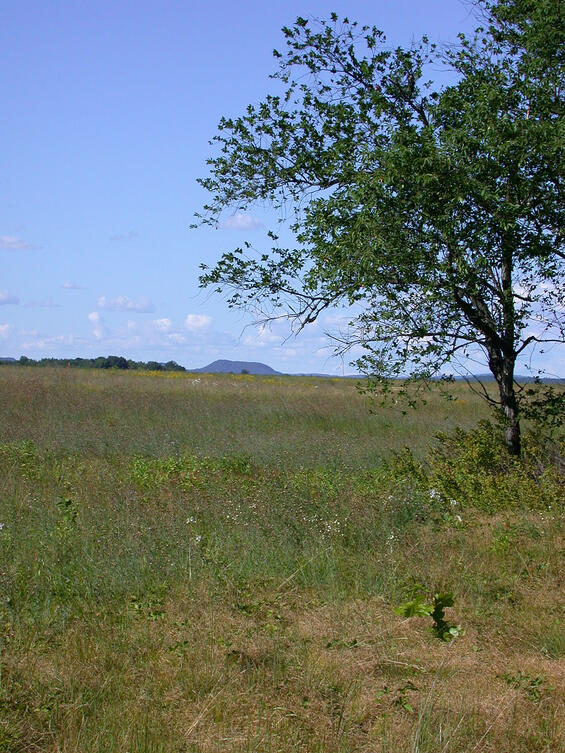- Scientific name: Apantesis phyllira
- Species of Greatest Conservation Need (MA State Wildlife Action Plan)
- Endangered (MA Endangered Species Act)
Description

Phyllira tiger moth, Apantesis phyllira, form phyllira (top) and form oithona (bottom).
The phyllira tiger moth (Apantesis phyllira) is an erebid moth with a wingspan of 35-40 mm (1.4-1.6 in) (Covell 1984). The forewing is black, with a cream-colored, longitudinal band along the cubital vein, and three concolorous transverse bands (distal, median, and proximal) between the costa and the cubital band. The distal band is jagged, forming two triangles with the median band. The proximal band is reduced or absent in some individuals. The margins of the forewing are also cream colored. The hind wing is red, with black costal and outer margins and spots. The head and thorax are cream colored with black stripes. The abdomen is red, with dorsal and lateral black stripes.

A second form of the phyllira tiger moth has cream-colored scales outlining the longitudinal veins of the forewing. This form was previously thought to be a separate species, Apantesis oithona. It is actually a genetic variant of the phyllira tiger moth, with the cream-colored scales outlining the veins of the forewing following a Mendelian pattern of inheritance (Nelson 2010).
Life cycle and behavior
In Massachusetts, the phyllira tiger moth has two broods, the first flying in late May and June and the second in August and early September. The female lays eggs loose, scattering them on the ground in the vicinity of suitable host plants. Eggs hatch within a week, and hatchlings commence feeding immediately upon locating a host plant. The larvae are ground dwelling and polyphagous, wandering to feed on a variety of low-growing herbaceous plants. Larvae pupate on the ground, in a cocoon composed of detritus loosely tied together with silk. Larvae from the second brood are about half grown by late October, at which time they seek a sheltered location to overwinter. They resume feeding in early spring, pupating in May.

Distribution and abundance
The phyllira tiger moth ranges from Maine south to Florida, and west to Alberta, Colorado, and Texas, although populations are sparsely distributed throughout most of this range (Schmidt 2009). In Massachusetts, this species is only known to occur at a single site in the Connecticut River Valley.

Distribution in Massachusetts.
1999-2024
Based on records in the Natural Heritage Database.
Habitat
In Massachusetts, the phyllira tiger moth inhabits sandplain grasslands, including grasslands maintained by anthropogenic disturbance such as pastures, old fields, airfields, and utility line rights-of-way.
Healthy habitats are vital for supporting native wildlife and plants. Explore habitats and learn about conservation and restoration in Massachusetts.

Sandplain grassland, habitat for the phyllira tiger moth.
Threats
The phyllira tiger moth is threatened by habitat loss and fire suppression in its disturbance-dependent habitat, specifically sandplain grasslands. Other potential threats include introduced generalist parasitoids, aerial insecticide spraying, non-target herbicide application, excessive deer browse of larval host plants, and off-road vehicles. This species is adapted to warm, dry grasslands, with a range extending south to Florida and west to Colorado. As such, the effects of climate change may not be detrimental to this species in Massachusetts.
Conservation
Land protection and habitat management are the primary conservation needs of this species in Massachusetts. In particular, xeric sandplain grasslands should be conserved, restored, and managed to maintain habitat for this species and other species dependent on such habitat.
Survey and monitoring
In Massachusetts, the phyllira tiger moth is only known to occur at a single site in the Connecticut River Valley. Other populations may exist in the state, though this is not likely since its relatively rare habitat has been well surveyed. The known populations of this species should be surveyed to document persistence at least once every 25 years; every 10 years is more desirable when practicable.
Management
Management of xeric sandplain grasslands benefits a suite of rare species, and habitat condition should be monitored and management adapted as needed.
Research needs
The natural history and conservation needs of the phyllira tiger moth are relatively well known. However, the future effects of a warming climate on this species are unpredictable and should be documented.
References
Covell, C.V. 1984. A Field Guide to Moths of Eastern North America. Peterson Field Guide Series. Houghton Mifflin, Boston, Massachusetts. 496 pp.
Nelson, M.W. 2010. Breeding evidence for conspecific status of Grammia phyllira (Drury, 1773) and Grammia oithona (Strecker, 1878) (Erebidae: Arctiinae), with notes on natural history and conservation status. Journal of the Lepidopterists’ Society 64(2): 57-68.
Schmidt, B.C. 2009. Taxonomic revision of the genus Grammia Rambur (Lepidoptera: Noctuidae: Arctiinae). Zoological Journal of the Linnean Society 156: 507-597.
Contact
| Date published: | March 21, 2025 |
|---|